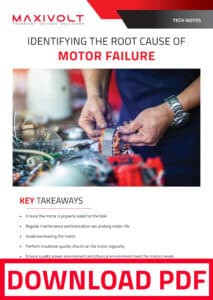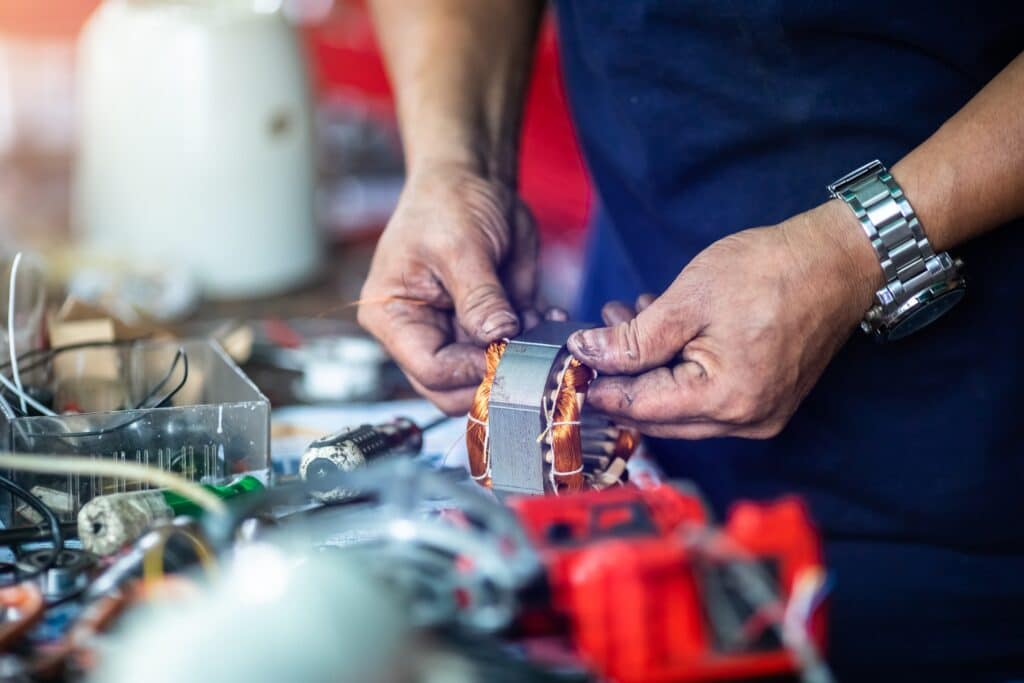Identifying the Root Cause of Motor Failure
Key Takeaways
Introduction
As motors become increasingly sophisticated, the potential for failure due to a combination of mechanical and electrical factors grows. Understanding the root cause of motor failures is essential to minimize costly downtime and ensure long-term reliability. While insulation breakdown and bearing wear are among the most common issues, failures can result from a wide range of sources.⁶ Properly diagnosing these issues not only prevents unexpected disruptions but also enhances asset performance and extends motor lifespan. In this article, we’ll explore key motor failure categories, both electrical and mechanical, and outline common causes and their impact on motor performance.
Motor Failure Categories
Motor failures fall into three basic categories: electrical, mechanical, and mechanical that progresses from electrical.
Electrical Causes of Motor Failure
Transient voltage
Short duration spikes in voltage within an electrical system (transient voltages) are caused by any sudden change in the system – such as equipment faults, switching loads, lightning strikes, etc.³ These power surges cause insulation breakdown and damage sensitive components within the motor, resulting in premature failure and downtime.
Voltage Imbalance
Voltage imbalance refers to a condition in a three-phase electrical system where the magnitudes or phase angles of the voltages between the phases are not equal. Ideally, in a balanced system, the voltages in each phase are identical in magnitude and are evenly spaced at 120° apart. When there is a voltage imbalance, one or more phases may experience higher or lower voltages than the others.² An imbalance in a motor of 2% or greater decreases the motor’s efficiency by generating extra heat within the motor, increasing its operating temperature and lowering its lifespan by decomposing the oil, grease or other components of the motor.
Harmonics
Harmonics are voltage or current waveforms that appear to be the multiples of the fundamental frequency of the system.³ If the system’s frequency is 60Hz, then the first harmonic would be 60Hz, the second would be 120Hz, and the third 180Hz. These can originate from variable frequency drives, power supplies, non-linear loads, transformer saturation, power factor correction capacitors, electronic devices and other industrial equipment within the system.
Sigma Currents
Also known as residual currents and shaft currents, sigma currents occur when the sum of the currents do not equal zero. This can be caused by harmonics, a phase imbalance, or current on your neutral in single phase motors. The motor could see a reduction in efficiency, torque pulsations, and overheating as well as a decrease in lifespan if the motor is exposed to these sigma currents.²
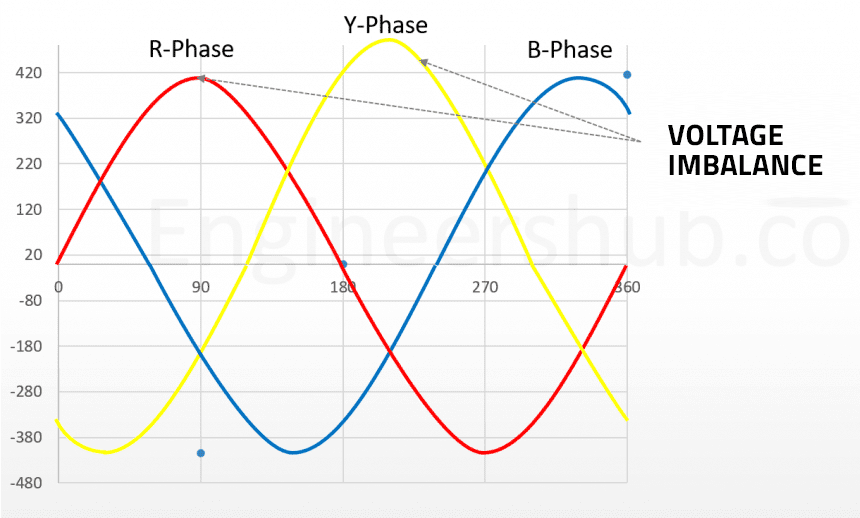
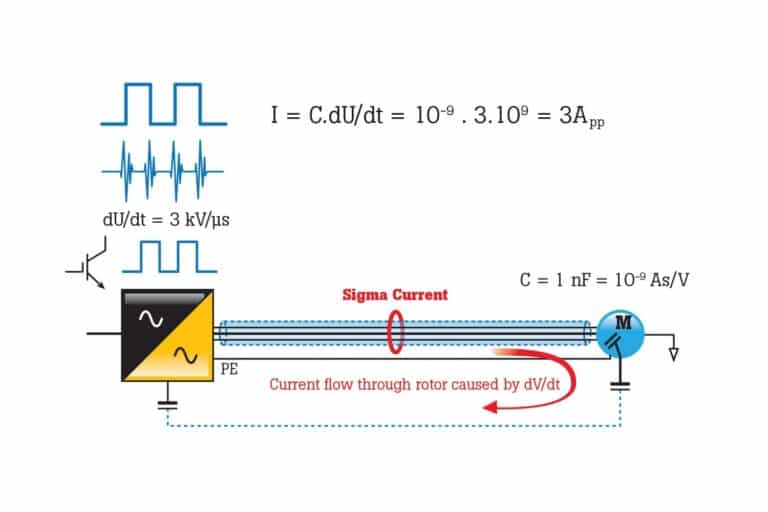
Overloads
A motor can be overloaded if:
- The mechanical load it is driving is greater than what the motor can perform or the load changes too frequently
- The supply voltage is too low for the motor to operate at an efficiency
- The ambient temperature is too high and the motor is unable to cool efficiently
- The motor has a faulty component (such as the rotor or bearings) that cause it to work harder and thus overheat.
Mechanical Causes of Motor Failure
Misalignment
This occurs when the motor’s shaft is not properly aligned with the driven equipment shaft (pump, fan, gearbox, etc.). This could be caused from improper installation, wear, and tear, foundation settling, thermal expansion, or even just vibrations alone.⁵
Shaft Imbalance
Shaft Imbalance develops when the mass distribution of the rotor or shaft is uneven, causing the center of mass to deviate from the axis of rotation. This imbalance results in uneven centrifugal forces during operation, leading to vibration, noise, and excessive wear on motor components.² This problem can stem from manufacturing defects, wear and tear, operational damage, material build up, or unbalanced add-ons to the machine.
Bearing Wear
Bearings wear normally through use, but certain aspects can stunt this vital component’s lifespan. They can wear more quickly due to friction, heat, contamination, improper lubrication, or misalignment.
Insulation Breakdown
Insulating material around the motor windings helps keep the phases separated and prevents electrical current from intermingling between the phases and/or the motor frame.¹ Causes of insulation breakdown include overheating, stress (whether electrical or mechanical), contamination, age, or partial electrical discharge.
Preventing Motor Failures: Proactive Strategies
To minimize the risk of motor failure, both electrical and mechanical factors must be addressed through a comprehensive maintenance and monitoring strategy. By implementing preventive measures, you can extend the lifespan of your motor, reduce downtime, and enhance overall system reliability.
Here are some key strategies to help prevent the common issues discussed above.
Preventing Electrical Failures
Transient Voltage:
Properly sized and applied Surge Protection Devices (SPDs) mitigate the effects of random, extreme spikes in voltage. This will protect your motor and help it maintain a smoother electrical experience as long as grounding is sound, and the voltages are already balanced.
Voltage Imbalance:
Install voltage monitors and voltage regulators to safeguard motors against imbalances and ensure consistency. Regularly inspect the electrical supply to ensure balanced voltages, verify the cable sizing is sized appropriately, and clean connections across all phases. If power factor correction is needed, an appropriately sized capacitor bank could be used to help balance out the voltages.
Harmonics:
Use harmonic filters (passive or active filters) to minimize the impact of harmonic distortion from non-linear loads. Harmonic filters, line conditioners, inductors, and capacitors, provide low impedance paths at the selected frequencies. Additionally, maintain proper power factor correction systems and review the compatibility of drives with your system to mitigate harmonic generation. These need to be placed near non-linear loads to help control the harmonics effects on the rest of the power system. Another way to mitigate harmonics is to use AC line reactors and DC link chokes because they reduce the peaks of the inrush current caused by Variable Frequency Drive inverters.
Sigma Currents (Residual Currents):
Regular monitoring with advanced motor protection relays and residual current devices (RCDs) can help detect phase imbalances and neutral current issues early on, reducing overheating and inefficiency. Balancing the load and ensuring proper wiring practices are also essential in controlling sigma currents.
Overloads:
Prevent motor overloads by properly sizing the motor for the load it drives. Ensure the motor is operated within its design limits by monitoring the load, supply voltage, and ambient temperature. Use overload relays or motor protection devices to automatically shut down the motor when overloading occurs.
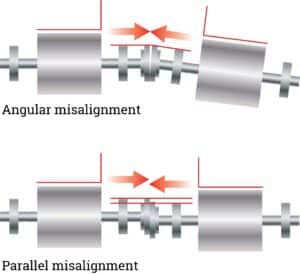
Preventing Mechanical Failures
Misalignment:
Misalignment is often a result of poor installation practices. Conduct an alignment check between the motor and the driven equipment using laser alignment tools. This will ensure the shafts are properly aligned, preventing excessive wear and vibration.⁵
Shaft Imbalance:
Ensure that rotors and shafts are properly balanced during both installation and maintenance. Periodically clean the motor to prevent material buildup that could lead to imbalance. If vibrations or noise develop, conduct a balancing test immediately to prevent damage.²
Bearing Wear:
To prevent premature bearing wear, use the correct type and grade of lubricant, and follow the manufacturer’s recommended lubrication schedule. Avoid over-lubrication, which can cause excess heat and lead to bearing failure. Also, keep the motor and surrounding environment clean to prevent contamination from debris or moisture.⁷
Insulation Breakdown:
Regularly inspect and test motor insulation to detect early signs of deterioration. Use insulation resistance testing (megger tests). For high voltage, use apartial discharge analysis to assess the condition of the insulation.¹
Maintain proper ventilation and cooling systems to prevent the motor from overheating (a major cause of insulation breakdown).¹ Keep the motor clean to prevent blockages in airways and ensure that fans are functioning correctly.
Finally, shield the motor from contaminants (dust, moisture, and corrosive chemicals) by using appropriate enclosures.¹
Conclusion
Identifying the root cause of motor failures is essential for maintaining the efficiency and reliability of industrial operations. Motor issues can stem from a variety of electrical and mechanical factors, each with its own set of symptoms and impacts. Electrical problems such as transient voltage spikes, voltage imbalances, harmonics, sigma currents, and overloads can lead to significant disruptions if not promptly addressed. Similarly, mechanical issues including misalignment, shaft imbalance, bearing wear, and insulation breakdown can exacerbate problems and lead to premature motor failure.
Understanding these potential causes allows for more effective troubleshooting and preventive measures. By conducting regular maintenance, monitoring performance indicators, and addressing issues as they arise, organizations can reduce downtime, extend motor life, and enhance overall operational efficiency. Proactive management and accurate diagnosis are key to mitigating risks and ensuring the continued success of motor-driven systems.
Resources
-
Kruger, B. (2022, July 8). Electrical insulation failure. CBM CONNECT®. www.cbmconnect.com/electrical-insulation-failure-2/
-
Artesis. (2022, September 3). 10 most common failures in electric motors. Artesis. www.artesis.com/10-most-common-failures-in-electric-motors/
-
Lawal, G. (2022, May 10). Common causes of motor failure. Gilautomation. www.gilautomation.com/blogs/news/common-causes-of-motor-failure
-
Bolotinha, Manuel. (2022, September 29). Motor protection – Types of faults and protection devices. Electrical Technology. www.electricaltechnology.org/2020/10/motor-protection-types-faults-protection-devices.html
-
Butcher, J. (2022, December 5). Common causes of motor failure & how to prevent them. Energy Management Corporation. www.goemc.com/2021/04/09/common-causes-of-motor-failure-how-to-prevent-them/
-
Duke Electric. (2024, July 30). The essential guide to electric motor failure. Duke Electric. www.dukeelectric.com/motors/failure/guide/
-
Fluke. 13 common causes of motor failure. Fluke. www.fluke.com/en-gb/learn/blog/motors-drives-pumps-compressors/13-common-causes-of-motor-failure
